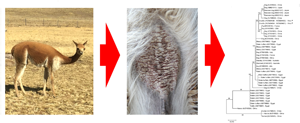Published online by Cambridge University Press: 05 November 2021

Sarcoptic mange is a disease caused by an infectious parasite in the vicuñas (Vicugna vicugna) from South America. Although molecular studies have provided much information about the epidemiology of this disease, this information is still unknown in vicuñas. This study determined the prevalence and molecular characterization of Sarcoptes scabiei from vicuñas from Southern Peruvian Andes. During the 2018 shearing season, 181 vicuñas were clinically evaluated for lesions compatible with mange. Sarcoptes scabiei was detected in 35 (19.3%) vicuñas, and 50 mites from 25 vicuñas were selected for molecular analyses of the mitochondrial (cox1) and nuclear (ITS2) genetic markers. Molecular analyses of the cox1 and ITS2 sequences showed an identity of 94–99% and 99.8–100% with previous S. scabiei sequences registered in the GenBank, respectively. Sequence polymorphisms were more evident in the ITS2 than in the cox1, but only the cox1 had an association with the host. Phylogenetic analysis of S. scabiei cox1 sequences from vicuñas showed a cluster with S. scabiei cox1 sequences from canids, suggesting that the origin of S. scabiei from vicuña is associated with canid mites. This research is the first molecular analysis of S. scabiei from vicuñas. Future molecular studies will be necessary to determine the species variety, geographic segregation and host–parasite adaptation for this vicuña's mite.